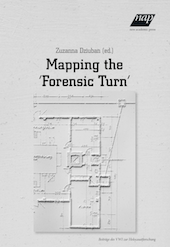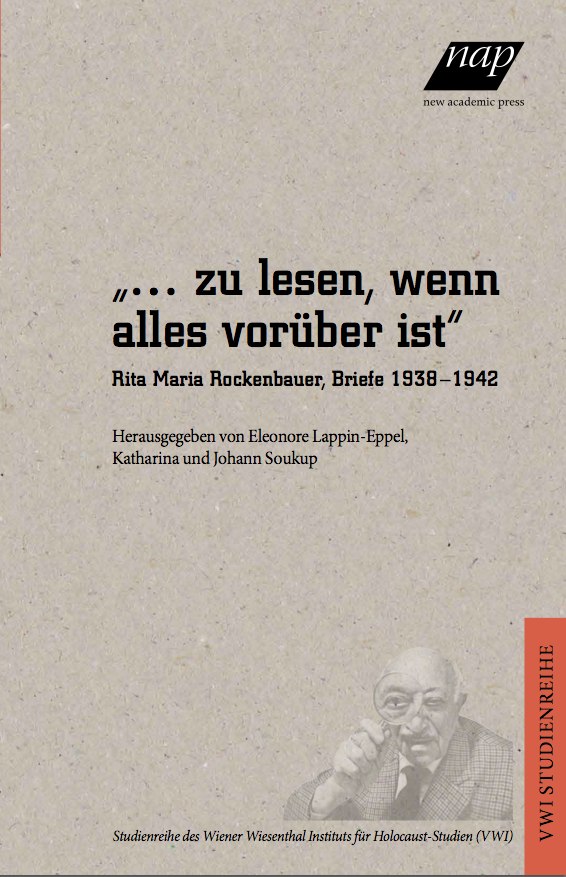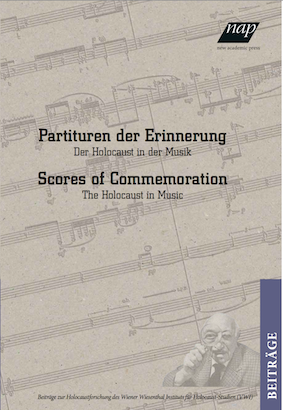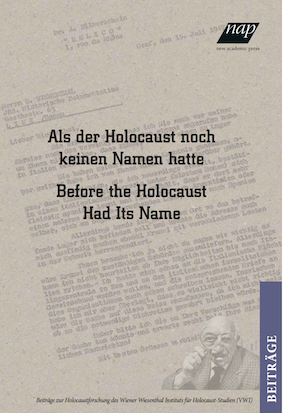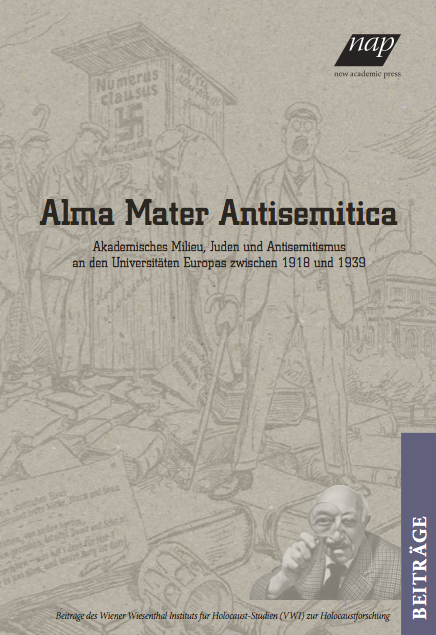 An inhospitable place: now void and empty, long-buried layers are surfacing again. The former office of the Communist Party can only be adumbrated; a monumental bar is all that remains of the former dance hall, the later installation of a supermarket disrupted the original spatial arrangement and the elaborate floor plan, leaving behind the scent of flesh, dusty heater fans and open fuse boxes. What could not be used was sealed off, producing dead spaces, vacant areas. Only traces on the walls, cracks and defects on the ceilings, rusty handrails and swinging doors speak from the deepest, original layer of the edifice. The synagogue, dedicated in 1932, accommodated 600 believers. Embedded in a residential building, the construction thus escaped complete destruction in the Viennese November Pogrom of 1938. But its extinction is nevertheless obvious and undeniable: less than a century later, quasi-archaeological methods and complex simulations are necessary to identify the former sacral building. With the removal of each layer – of the former supermarket, of the chemist’s shop, of the dance hall or the party office – a deeper layer come’s to the fore, exposing the monstrous desecration of the original function of this place. The great fire that destroyed the original installation in the November Pogrom was on the beginning: its desecration was continued thereafter through forgetting, ignoring, neglecting what was once here, because nobody remained after 1945 for whom this original layer was of any importance, who could give back this space its unique sacredness.
An inhospitable place: now void and empty, long-buried layers are surfacing again. The former office of the Communist Party can only be adumbrated; a monumental bar is all that remains of the former dance hall, the later installation of a supermarket disrupted the original spatial arrangement and the elaborate floor plan, leaving behind the scent of flesh, dusty heater fans and open fuse boxes. What could not be used was sealed off, producing dead spaces, vacant areas. Only traces on the walls, cracks and defects on the ceilings, rusty handrails and swinging doors speak from the deepest, original layer of the edifice. The synagogue, dedicated in 1932, accommodated 600 believers. Embedded in a residential building, the construction thus escaped complete destruction in the Viennese November Pogrom of 1938. But its extinction is nevertheless obvious and undeniable: less than a century later, quasi-archaeological methods and complex simulations are necessary to identify the former sacral building. With the removal of each layer – of the former supermarket, of the chemist’s shop, of the dance hall or the party office – a deeper layer come’s to the fore, exposing the monstrous desecration of the original function of this place. The great fire that destroyed the original installation in the November Pogrom was on the beginning: its desecration was continued thereafter through forgetting, ignoring, neglecting what was once here, because nobody remained after 1945 for whom this original layer was of any importance, who could give back this space its unique sacredness.
Editorial
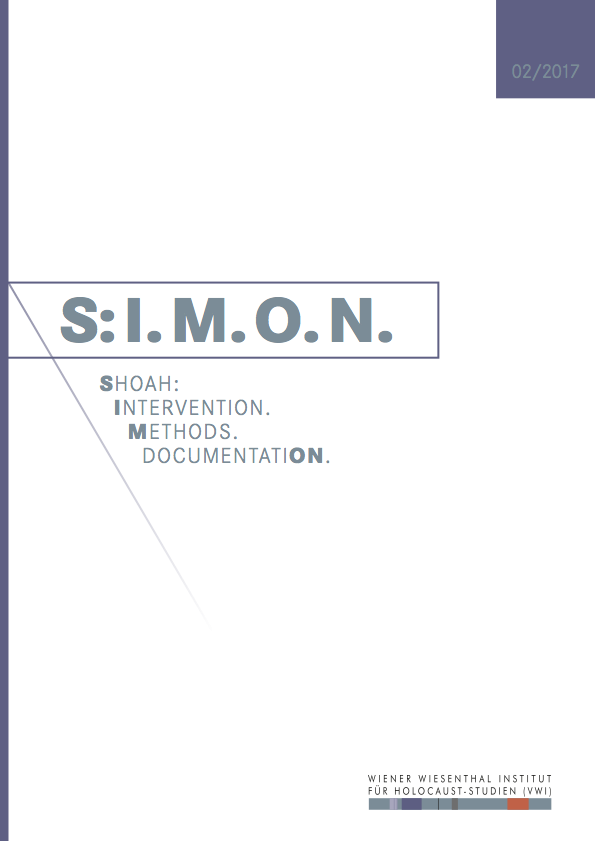 S:I.M.O.N. is an e-journal of the Vienna Wiesenthal Institute for Holocaust Studies (VWI). It appears twice a year in English and German language. S:I.M.O.N. aims at both a transnational and comparative history of the Holocaust and Jewish Studies in Central and Eastern Europe within the broader contexts of the European history of the 20th and 21st century, including its prehistory, consequences and legacies as well as the history of memory.
S:I.M.O.N. is an e-journal of the Vienna Wiesenthal Institute for Holocaust Studies (VWI). It appears twice a year in English and German language. S:I.M.O.N. aims at both a transnational and comparative history of the Holocaust and Jewish Studies in Central and Eastern Europe within the broader contexts of the European history of the 20th and 21st century, including its prehistory, consequences and legacies as well as the history of memory.
S:I.M.O.N. serves as a forum for discussion of various methodological approaches. The journal especially wishes to strengthen the exchange between researchers from different scientific communities and to integrate both the Jewish history and the history of the Holocaust into the different “national” narratives. It also lays a special emphasis on memory studies and the analysis of politics of memory. S:I.M.O.N. uses a double-blind review system, which means that both the reviewer’s and the author’s identities are concealed from each other hroughout the review process.
Shoah: The journal deals with the history of the Shoah from multidisciplinary, transnational and comparative perspectives. It seeks to integrate studies on Jews as well as on other groups of victims of the Holocaust, especially on Roma, and of so far less researched regions of (East) Central and (South) Eastern Europe.
Intervention. The journal reports on research projects and their transmission into public events. It also informs about current educational and remembrance programs.
Methods. The journal serves as a forum for the discussion of methodological approaches as, for instance, the everyday history, oral history, gender history, the history of violence, anti-Semitism and racism and the theory of memory and memory politics.
DocumentatiON. The journal contributes to critical approaches on using and interpreting archival materials in the 21st century.
Download the current issue S:I.M.O.N. 2017/2.
Articles
Christina Winkler
Der russische Blick auf die Shoah
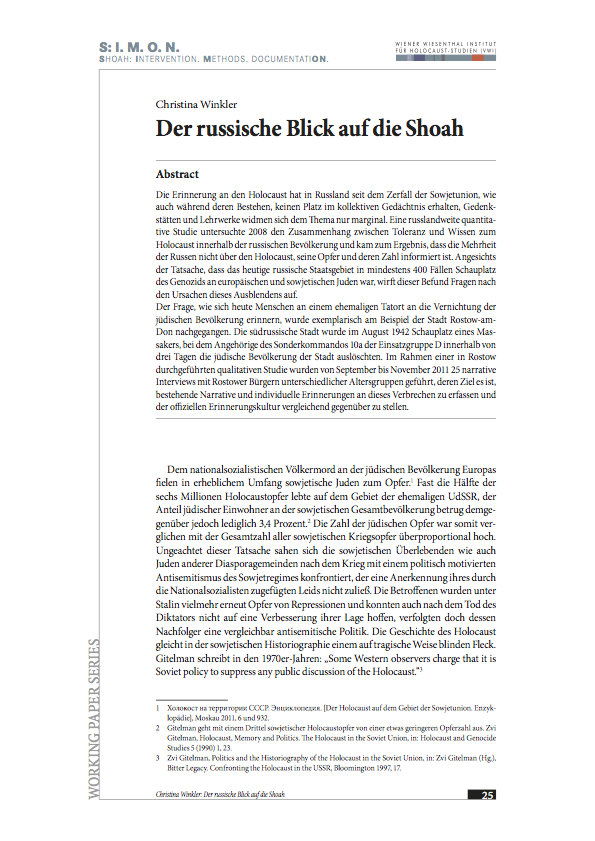 Both during the Soviet era and after its collapse, there has been no room for Holocaust remembrance in Russia's collective memory; memorials and textbooks only marginally touch on the topic. In 2008, quantitative research across Russia investigated the relationship between tolerance and Holocaust knowledge within the Russian population and concluded that the majority of Russians were not aware of the Holocaust, its victims and their numbers. Considering the fact that the current territory of Russia includes at least 400 sites of perpetration of the genocide of European and Soviet Jews, these results urge the question of the causes for this suppression.
Both during the Soviet era and after its collapse, there has been no room for Holocaust remembrance in Russia's collective memory; memorials and textbooks only marginally touch on the topic. In 2008, quantitative research across Russia investigated the relationship between tolerance and Holocaust knowledge within the Russian population and concluded that the majority of Russians were not aware of the Holocaust, its victims and their numbers. Considering the fact that the current territory of Russia includes at least 400 sites of perpetration of the genocide of European and Soviet Jews, these results urge the question of the causes for this suppression.
The city of Rostov-on-Don served as an example in order to address the question of how people now remember the former site of the extermination of the Jewish population. This southern Russian city became the site of a massacre in August 1942, when members of the special commando 10a, part of Einsatzgruppe D annihilated the Jewish population of the city within three days. In the context of qualitative research undertaken in Rostov, 25 narrative interviews were conducted with citizens of Rostov from a range of age groups between September and November 2011. It was the aim of the interviews to record the existing narrative and individual memories of this crime and to compare and contrast these with the official culture of remembrance.
SWL-Reader
Paul A. Shapiro
Opening the Archives of the International Tracing Service (ITS). How did it happen? What does it mean?
Until the end of 2007, the International Tracing Service (ITS) was the largest collection of inaccessible records anywhere in the world that shed light on the fates of people from across Europe – Jews as well as members of virtually every other nation or nationality – who were arrested, deported, sent to concentration camps, and even murdered by the Nazis; who were put to forced labour, calculated in many places to result in death; and who were displaced from their homes and families, and unable to return home at the war’s end. These were documents that Allied forces collected as they liberated camps and forced labour sites across Europe in the last months of the war and during their post-war occupation and administration of Germany and Austria.
The archives of the ITS in Bad Arolsen, Germany, contains over fifty million documents produced in the Second World War era relating to the fates and destinies of over 17.5 million people. Using samples and case studies, the author, who led the campaign to open the archives, provides a view of the effort to open the collections for research and discuss the importance of this recent event for Holocaust survivors, victims of National Socialism, and scholars.
Events
Zoltán Halasi
Duschehubka
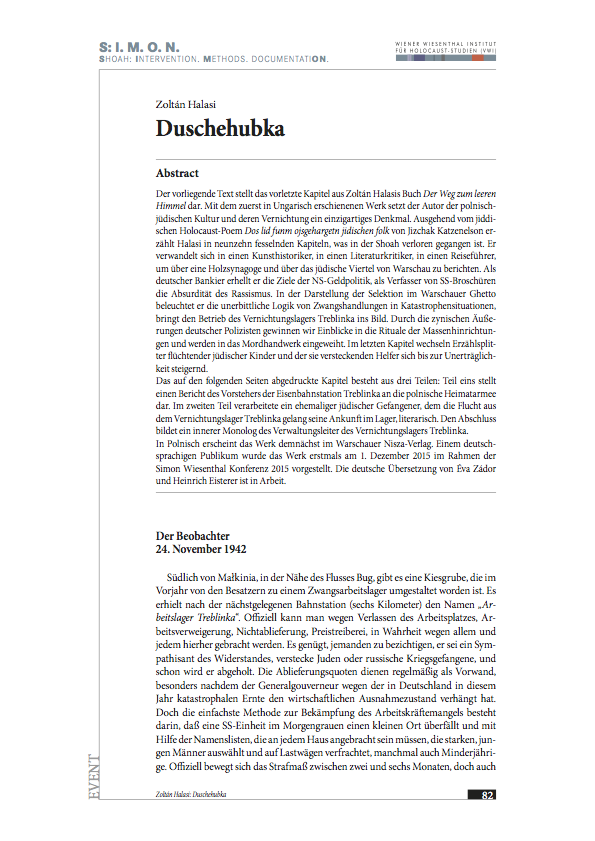 This text is the penultimate chapter of Zoltán Halasi's book Út az üres éghez (Road to an Empty Sky). With this work, which was first published in Hungarian, the author created a singular memorial to Polish-Jewish culture and its destruction. Setting out from the Yiddish Holocaust poem Dos lid funm ojsgehargetn jidischen folk by Itzhak Katzenelson, Halasi records what was lost in the Shoah in the course of nineteen compelling chapters. He takes on the grab of an art historian, a literary critic and a travel guide when he reports about a wooden synagogue and the Jewish quarter in Warsaw. In the role of a German banker, he illuminates the aims of the Nazi monetary policies, as a writer of SS brochures he highlights the absurdity of racism. Depicting a Selektion in the Warsaw ghetto, he shows the grim logic of compulsive acts in catastrophic situations, draws an image of the running of the extermination camp Treblinka. The cynical words of two German policemen provide an insight into the rituals of mass executions and introduce us to the craft of murder. The final chapter is an interplay of slithers of narrative by Jewish children on the run and by those who helped and hid them that borders on the unbearable.
This text is the penultimate chapter of Zoltán Halasi's book Út az üres éghez (Road to an Empty Sky). With this work, which was first published in Hungarian, the author created a singular memorial to Polish-Jewish culture and its destruction. Setting out from the Yiddish Holocaust poem Dos lid funm ojsgehargetn jidischen folk by Itzhak Katzenelson, Halasi records what was lost in the Shoah in the course of nineteen compelling chapters. He takes on the grab of an art historian, a literary critic and a travel guide when he reports about a wooden synagogue and the Jewish quarter in Warsaw. In the role of a German banker, he illuminates the aims of the Nazi monetary policies, as a writer of SS brochures he highlights the absurdity of racism. Depicting a Selektion in the Warsaw ghetto, he shows the grim logic of compulsive acts in catastrophic situations, draws an image of the running of the extermination camp Treblinka. The cynical words of two German policemen provide an insight into the rituals of mass executions and introduce us to the craft of murder. The final chapter is an interplay of slithers of narrative by Jewish children on the run and by those who helped and hid them that borders on the unbearable.
The chapter reproduced on the following pages has three parts: Part one is a Treblinka railway station master's report to the Polish Home Army. In the second part, a former Jewish detainee who managed to escape from the extermination camp Treblinka gives a literary treatment of his arrival at the camp. The final part consists of an inner monologue by the Treblinka extermination camp's director of administration.
The book will shortly be published in Polish at the Nisza publishing company in Warsaw. The German-speaking public was first presented with the work on December 1, 2015 at the Simon Wiesenthal Conference 2015. The German translation by Éva Zádor and Heinrich Eisterer is in progress.
Béla Rásky/Werner Michael Schwarz: Spurensuche an einem vergessenen Ort. Ein Abend in der ehemaligen Synagoge Kaschlgasse 9. November 2010
„... zu lesen, wenn alles vorüber ist“
Rita Maria Rockenbauer, Briefe 1938 –1942
Wien 2014
Partituren der Erinnerung.
Der Holocaust in der Musik
Scores of Commemoration.
The Holocaust in Music
Wien 2015
Before the Holocaust Had Its Name. Early Confrontations of the Nazi Mass Murder of the Jews
Wien 2016
Akademisches Milieu, Juden und Antisemitismus an den Universitäten Europas zwischen 1918 und 1939
Academic Milieu, Jews and Antisemitism at European Universities between 1918 and 1939
Wien 2016



